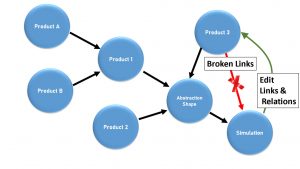Have you been to the SIMULIA Community lately? If you want the best content, access to our verified SIMULIA experts, a forum to ask questions, and more, then this is the place for you! Our community is engaged and informed about the latest in simulation trends, as well as providing solutions to complex engineering problems. And if you want access to Best Practice documents like the one described below, all you need to do is join for free!
This is the first post in a series of SIMULIA Community Best Practices featured on the blog. Come back for more posts about SIMULA Best Practices and other interesting simulation content.

Traditionally, modeling was carried out using different tools, which led to an inconsistent relationship between the designer and the analyst. Dassault Systèmes modeled the form and fit in a set of tools, and modeled function in another set of tools. Using separate tools meant lengthy design cycles due to the overhead of communication and data transfer between the designer and the analyst using a file-based PLM approach. By using a model-based approach the 3DEXPEREINCE platform has combined the form and fit in 3D models with the function in CAE by creating a seamless integration of the designer and analyst workspaces. This has opened new avenues for collaboration and with it the necessity to control and handle changes.
The 3DEXPERIENCE platform provides a handful of choices in terms of mechanisms available to control and handle change. The right choice of the mechanism is dependent on variables such as organization size, how the designers (CAD team) and analysts (CAE team) communicate, size of the models, familiarity and willingness from the designer to handle finite element representations (FEM reps), and so on.
This document discusses one such mechanism. The methodology discussed in this document is better suited for relatively smaller organizations that have strong communication between the designer and analyst. It is geared towards the analyst in the sense that there is no finite element overhead to be managed by the designer. The analyst owns all the finite element related data and controls the flow of CAD changes from the designer.
Prerequisites and recommendations: This document is intended to complement the existing formal training, documentation, and knowledgebase articles and not to replace them in any form.
Use this document in conjunction with the relevant training materials such as:
- Structural Model Creation Essentials
- Model Assembly Design Essentials
- Structural Scenario Creation Essentials
Targeted audience: Customers using SIMULIA apps and Technical Support Engineers.
In this Best Practice you will learn about:
- Using Abstraction shapes to provide seamless integration between CAD and CAE.
- Editing and Synchronizing Links and Relations.
Looking for more such Best Practices? Get them HERE.
*Please note that you will need a valid DS Passport account with appropriate user role to access Best Practice Documents. Please contact your Dassault Systèmes representative for issues related to your account.
SIMULIA offers an advanced simulation product portfolio, including Abaqus, Isight, fe-safe, Tosca, Simpoe-Mold, SIMPACK, CST Studio Suite, XFlow, PowerFLOW and more. The SIMULIA Community is the place to find the latest resources for SIMULIA software and to collaborate with other users. The key that unlocks the door of innovative thinking and knowledge building, the SIMULIA Community provides you with the tools you need to expand your knowledge, whenever and wherever.


